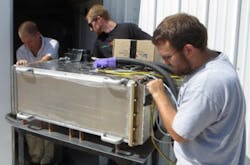Las Cumbres Observatory achieves first light with NRES spectrograph
| The prototype NRES is installed at the Sedgwick Observatory. (Image: LCOGT) |
Goleta, CA--Las Cumbres Observatory Global Telescope (LCOGT) achieved first light with its prototype Network of Robotic Echelle Spectrograph (NRES) the week of Oct. 12, 2012. The event took place at LCOGT’s Byrne Observatory, located at the UC Santa Barbara Sedgwick Reserve.
The NRES, funded through a National Science Foundation Major Research Instrumentation (MRI) grant, will extend the capabilities of the LCOGT one-meter network with six identical high-resolution (R of about 53,000), precise (better than 3 m/s), optical (380 to 860 nm) echelle spectrographs. Primarily designed to support the study of exoplanets, the NRES prototype represents more than two years of science and engineering work at Las Cumbres Observatory.
“We adopted an optical design that is both simple and conventional in its general approach, similar in concept to spectrographs designed for the Palomar East Arm Echelle, the Lick Automated Planet Finder, and others," says astronomy postdoc Jason Eastman. The in-house design enabled Las Cumbres to optimize the spectrograph for a small production run and robotic use; there will be six of the NRES instruments deployed at six geographically distributed sites around the world and integrated through a global telescope scheduling and control system.
Doubling the resource
Exoplanet candidates are identified through a variety of means, but most are generated through transit surveys like Kilodegree Extremely Little Telescope (KELT), Hungarian Automated Telescope Network (HATNet), Wide Angle Search for Planets (WASP), Kepler, and COnvection ROtation and planetary Transits (CoRoT). Follow-up by targeted optical telescopes is required to confirm and characterize the exoplanets.
Separating planets from false positives is efficiently done with (and often demands) radial velocity (RV) measurements to distinguish the reflex velocities due to planets (on the order of m/s) from the velocities due to stellar companions (on the order of km/s). In addition, knowing the mass, radius, and temperature of an exoplanet depends on obtaining the same physical properties of its parent star. This requires spectroscopic classification of the star.
The LCOGT Network of Robotic Echelle Spectrographs (NRES) will roughly double the radial velocity observing capacity nationwide, enabling astronomers to vet the many exoplanet candidates generated from current and future surveys.
NRES spectrographs will be deployed as instruments on the LCOGT one-meter telescope network. Each NRES spectrograph consists of two acquisition/guider units (on two separate one-meter telescopes), a simultaneous thorium argon and flat-field calibration source, and spectrograph with precise thermal and pressure regulation. The design achieves high optical throughput, wide wavelength coverage, and simultaneous fiber input from two telescopes.
Source: http://lcogt.net/press-release/las-cumbres-observatory-achieves-first-light-nres-spectrograph
